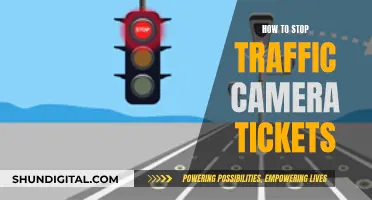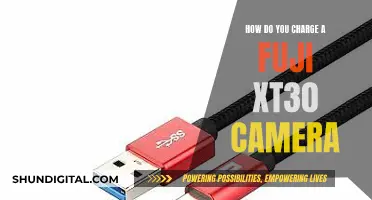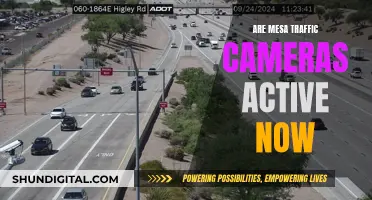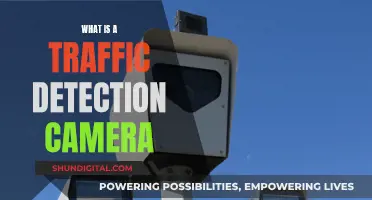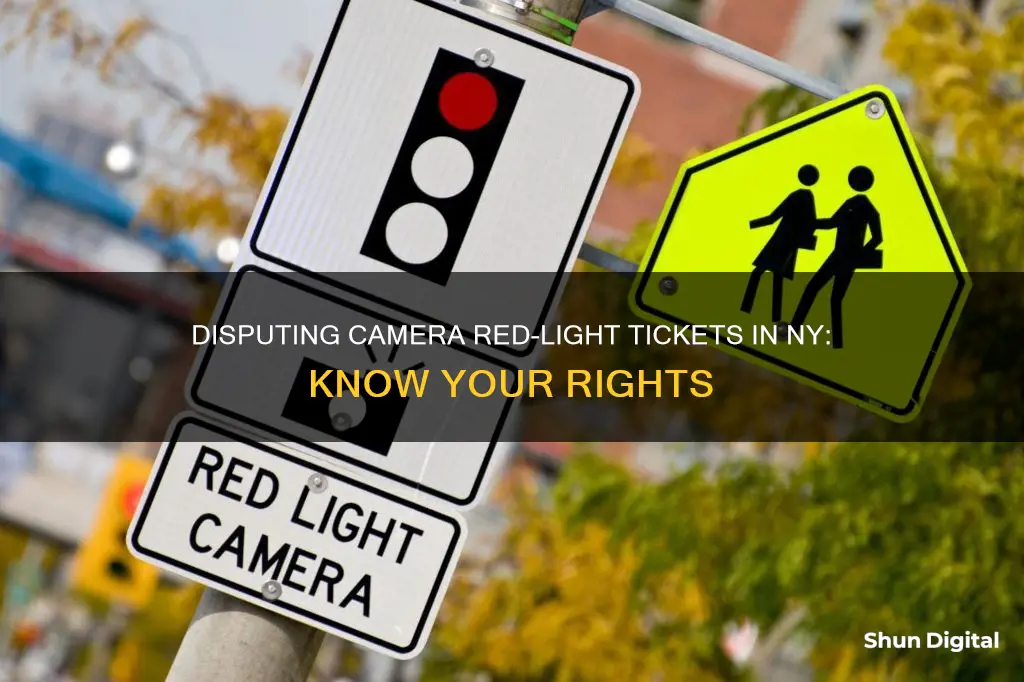
Receiving a red light camera ticket in New York can be frustrating and expensive. However, it is important to remember that you have the right to contest the citation if you believe it was issued unfairly. While the process may seem intimidating, understanding the steps to take can significantly improve your chances of successfully challenging the ticket. This paragraph aims to provide an overview of the process for disputing a camera red light ticket in New York, covering key aspects such as reviewing the ticket, researching the violation, gathering evidence, and navigating the appeal process.
| Characteristics | Values |
|---|---|
| Time limit to request a hearing | 30 days after the ticket was issued |
| Ways to dispute a ticket | Online, by mail, via the Pay or Dispute mobile app, or in person |
| Ticket information to check | Date, time, location, alleged violation, images or video evidence |
| Evidence to gather | Photographs, video footage, eyewitness statements, technical issues with the camera |
| Camera requirements in New York | Maintenance records and calibration certifications |
| Appeal content | Concise, factual, respectful, and explaining why the ticket is unjust |
What You'll Learn
- Check the ticket details: date, time, location, and alleged violation
- Research the specific red light camera laws and regulations in New York
- Gather evidence: photos, videos, eyewitness statements, or technical issues with the camera
- Verify the camera's maintenance records and calibration certifications
- Draft and submit a formal appeal letter to the appropriate authority

Check the ticket details: date, time, location, and alleged violation
When you receive a red-light camera ticket in New York, it's important to carefully review the details of the ticket. Check that the date, time, location, and alleged violation are accurate. Make sure that any images or video evidence clearly show the violation and correctly identify your vehicle.
The date on the ticket should match the date of the alleged violation. Confirm that the time on the ticket corresponds accurately to the time of day when the violation is said to have occurred. Check that the location information on the ticket matches the location where the violation allegedly took place. This may include the name of the street, the nearest intersection, or other relevant details.
Pay close attention to the description of the alleged violation. The ticket should specify the nature of the violation, such as running a red light, failing to come to a complete stop before turning right, or illegally rolling through a red light. Make sure you understand the specific violation you are being charged with and review the applicable traffic laws and regulations.
It is important to carefully examine any accompanying images or video footage. Look for clear evidence that your vehicle committed the violation. Check that the license plate number in the images or footage matches your vehicle's registration. If there are multiple vehicles in the photo or video, confirm that yours is the one accused of the violation.
If any of the details on the ticket are inaccurate or inconsistent with the evidence provided, this may form the basis for disputing the ticket. For example, if the date, time, or location information is incorrect, it could call into question the validity of the entire ticket. Similarly, if the images or video footage do not clearly show your vehicle committing the violation, or if your vehicle is not the one captured in the media, you may have grounds for a dispute.
Remember, reviewing the ticket details is a crucial step in the process of disputing a red-light camera ticket in New York. By carefully checking the information provided, you can identify any discrepancies or errors that may support your case for disputing the ticket.
The Rarity of Epson R-D1 Rangefinder Cameras
You may want to see also

Research the specific red light camera laws and regulations in New York
When researching the specific red light camera laws and regulations in New York, it's important to understand the legal requirements, your rights, and the potential penalties for this type of violation. Here's a detailed guide to help you navigate the process:
Understanding the Law:
Intersections in New York typically have a designated stopping point, such as a crosswalk, a specific stop line, or the curb line if there are no painted lines. The key factor is whether a driver crosses this stopping point when the light is red. This is what a police officer should be observing when issuing a red light ticket.
The most common scenario leading to a red light ticket is when a driver proceeds through an intersection after the light has turned red. However, there are grey-area situations. For example, a driver may enter the intersection just as the light turns from yellow to red, or they may enter on a green light but be delayed in clearing the intersection due to congestion or waiting for a gap in traffic. These "delay" situations are legal maneuvers, and an officer must pay close attention to the entire intersection and the light cycle to accurately assess if a violation has occurred.
Knowing Your Rights:
It's important to understand that you have the right to contest a red light camera ticket if you believe it was issued in error. You can review the information on the ticket, including the date, time, location, and alleged violation. Examine any images or video evidence provided to ensure it clearly shows the violation and accurately identifies your vehicle. If you were not the driver at the time of the incident, you may need to identify the actual driver during the appeal process.
Researching Penalties and Defenses:
Familiarize yourself with the potential penalties for running a red light in New York. Also, research possible defenses and gather any evidence that supports your claim of innocence. This could include photographs, video footage, eyewitness statements, or technical issues with the red light camera. If you believe the yellow light duration was insufficient, collect data to support this claim.
Verifying Camera Equipment:
New York has specific standards for red light cameras, and the accuracy of the equipment is crucial to the validity of the ticket. Verify the camera's maintenance records and calibration certifications. If there are any issues or discrepancies, this can be used as evidence to contest the ticket.
By thoroughly researching the specific red light camera laws and regulations in New York, you can empower yourself with knowledge and build a strong case to dispute your ticket. Remember to pay attention to details, gather evidence, and understand your rights and options for appealing the decision.
Charging Cove Outdoor Camera: A Step-by-Step Guide
You may want to see also

Gather evidence: photos, videos, eyewitness statements, or technical issues with the camera
To dispute a red-light camera ticket in New York, you must gather evidence to support your claim of innocence. This evidence can be in the form of photos, videos, eyewitness statements, or technical issues with the camera. Here are some detailed steps to help you gather this evidence effectively:
- Photographs and Video Footage: Obtain photographs or video footage of the incident that clearly show the intersection, the traffic signals, and your vehicle. Review the images or footage carefully to identify any inconsistencies or defects. For example, check if the red light was only for a turning lane and not the lane you were travelling in.
- Eyewitness Statements: If there were any eyewitnesses to the incident, such as passengers in your vehicle or pedestrians, obtain written statements from them. These statements should describe what they saw, including the colour of the traffic signals and your vehicle's position.
- Technical Issues with the Camera: Research the specific red light camera laws and regulations in New York to understand the technical standards the cameras must meet. Verify the maintenance records and calibration certifications of the camera in question. If there are any issues or discrepancies, document them as evidence.
- Yellow Light Duration: If you believe that the yellow light duration was too short, collect data and evidence to support this claim. This may include expert opinions or studies on the appropriate yellow light duration for that particular intersection.
- Vehicle Information: If you were not the driver of your vehicle at the time of the incident, you may need to identify the actual driver. Gather information such as contact details and a statement from the person who was driving.
Remember to review all the evidence carefully and cross-reference it with the information on the ticket. By gathering this evidence, you can strengthen your case and improve your chances of successfully disputing the red-light camera ticket.
Battery Pack Cameras: Powering Remote Photography
You may want to see also

Verify the camera's maintenance records and calibration certifications
When disputing a red-light camera ticket in New York, one important step is to verify the camera's maintenance records and calibration certifications. Here are some detailed instructions on how to do this:
Firstly, understand that red light cameras in New York must meet specific standards, as outlined by the relevant authorities. These standards ensure that the equipment is accurate and properly calibrated. You can request access to the maintenance records of the specific camera that issued your ticket. These records should detail any repairs, replacements, or adjustments made to the camera, as well as the dates of these actions. Check for any recent issues or problems with the camera that may have impacted its accuracy.
Next, review the calibration certifications. Calibration certifications are documents that confirm the camera has been properly calibrated and is functioning accurately. These certifications should be issued by a qualified technician or organization and may include details such as the date of calibration, the methods used, and any relevant test results. Check that the camera was calibrated recently and that the calibration was successful.
By examining the maintenance records and calibration certifications, you can verify that the camera was in proper working order and providing accurate data at the time your ticket was issued. If you discover any discrepancies, such as overdue maintenance or failed calibration tests, this can be used as evidence to support your dispute.
In addition to reviewing the camera's records, you may also want to research the specific make and model of the camera. Look for any known issues or recalls associated with that particular camera model. This can provide further evidence to support your case. Remember to be thorough in your research and document any relevant information you find.
Finally, if you identify any issues with the camera's maintenance or calibration, be sure to include this information in your formal appeal letter. Clearly explain how the camera's inaccuracies or malfunctions may have impacted the validity of your ticket. Provide as much detail as possible, including any specific maintenance or calibration issues you have identified. This will strengthen your case and improve your chances of a successful dispute.
Importing TIFFs: Camera Raw's Power
You may want to see also

Draft and submit a formal appeal letter to the appropriate authority
Step 1: Review your ticket
Check the date, time, and location of the ticket. As camera tickets are typically sent to the owner of the car, ensure that you were, in fact, the driver at the time of the incident. If not, you may need to identify the actual driver in the appeal process.
Step 2: Research the violation
Before drafting your appeal, research the specific red light camera laws and regulations in New York. Understand the legal requirements and potential penalties for this violation. This knowledge will help you build a solid case for your appeal.
Step 3: Gather evidence
Collect any evidence that supports your claim of innocence. This may include photographs, video footage, eyewitness statements, or technical issues with the red light camera. If you believe the yellow light duration was inadequate, gather data to support your claim. Ensure you have all the necessary documentation to present a compelling case.
Step 4: Check the camera equipment
Verify the red light camera's maintenance records and calibration certifications. In New York, red light cameras must meet specific standards, and the accuracy of the equipment is crucial to the validity of the ticket. Any issues with the camera's maintenance or calibration can be used as evidence to support your appeal.
Step 5: Draft your appeal letter
Prepare a formal appeal letter, addressing it to the appropriate authority that handles red light camera tickets in New York. Be concise, factual, and respectful in your appeal. Clearly explain why you believe the ticket is unjust, and present the evidence you have gathered to support your case. Include any relevant documentation and a copy of the ticket, if necessary.
Step 6: Submit your appeal
Submit your appeal and supporting evidence by mail or through the specified online portal. Keep a copy of everything you send for your records. Once your appeal is received, the authorities will review your case and make a decision. Note that this process may take several weeks.
Step 7: Follow up if needed
If your appeal is successful, the ticket will be dismissed, and you will not be required to pay the fine. However, if your appeal is denied, you may need to consider further legal options, such as requesting a hearing or consulting with an attorney. Remember that you have the right to contest the citation if you believe it was issued in error.
Keep Camera Batteries Warm for Winter Photography
You may want to see also
Frequently asked questions
The first step is to carefully review all the information provided on the ticket. Check for accuracy in the date, time, location, and the alleged violation. Make sure that you were driving the car when the ticket was issued, as the ticket is sent to the owner of the car and not the driver.
Research the specific red-light camera laws and regulations in New York to familiarize yourself with the legal requirements and potential penalties for this violation.
Gather any evidence that supports your claim of innocence, such as photographs, video footage, eyewitness statements, or technical issues with the red-light camera.
You can still dispute the ticket by drafting a formal appeal letter to the appropriate authority. Clearly explain why you believe the ticket is unjust and present any relevant evidence to support your claim.
Yes, you must request a hearing within 30 days after the ticket was issued to avoid paying late penalties. You can dispute the ticket online, by mail, via a mobile app, or in person.



